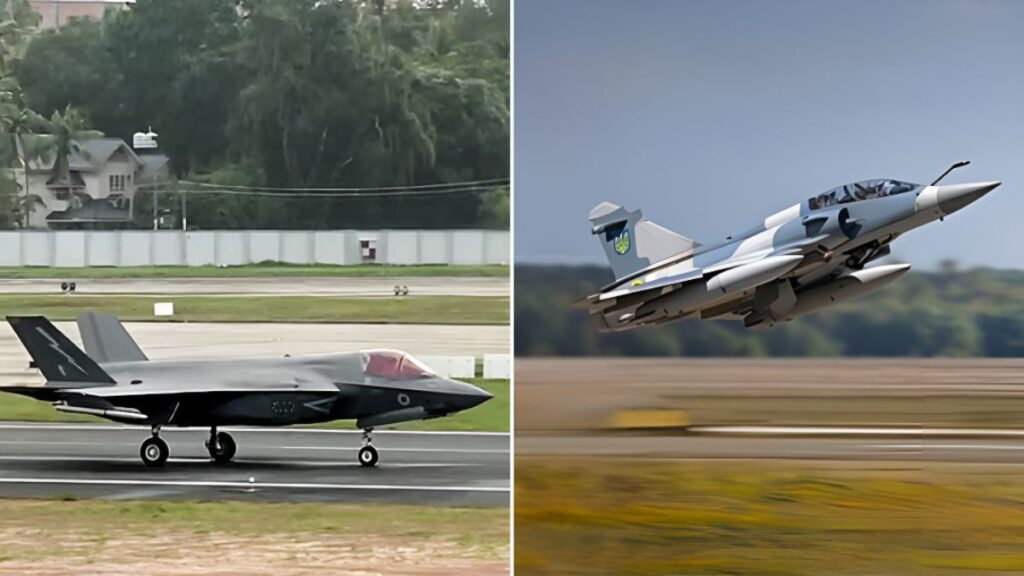So Much Hype Around UK’s Stranded F-35B; But Did You Know an IAF Pilot Pulled Off a Riskier Jet Recovery Flight From Mauritius in 2004?

PuneNow, July 23, 2025: As the British Royal Navy finally managed to extract its high-tech F-35B stealth fighter from Thiruvananthapuram International Airport after 38 days of repairs, the moment made headlines across India. The $110 million aircraft had made an emergency landing on June 14 during a maritime exercise and was grounded until Tuesday, when British engineers flew it out to Darwin, Australia.
After 38 days on ground, @RoyalNavy F-35 finally takes off. Farewell & happy landings! pic.twitter.com/8XmuzKoiuN
— Shiv Aroor (@ShivAroor) July 22, 2025
But few remember that two decades ago, the Indian Air Force faced a far more dangerous challenge — when a Mirage-2000 crash-landed in Mauritius and was deemed nearly unsalvageable. What followed was one of the boldest peacetime operations in Indian aviation history — a transoceanic rescue mission led by a fearless pilot, limited fuel, and no room for error.
A Damaged Jet on Foreign Soil
On October 4, 2004, an Indian Mirage-2000 fighter jet, fresh off an airshow in Mauritius, crash-landed belly-first at the Sir Seewoosagur Ramgoolam International Airport in Port Louis. The damage was severe — its underbelly fuel tanks, airframe, avionics, and cockpit instrumentation were compromised.
The aircraft was practically grounded for good. Yet, the IAF decided it wouldn’t give up without a fight.
Within days, an elite IAF technical team flew to Mauritius aboard an IL-76 transport aircraft, supported by an IL-78 aerial refuelling tanker. Their mission: repair the Mirage on-site and fly it back to India — through one of the most isolated and unforgiving air corridors in the world.
One Man, One Jet, Endless Ocean
By October 13, the Mirage was ready for ground runs. A test flight followed the next day, but more complications emerged: glitches in its fly-by-wire system, rudder issues, unresponsive gauges, and unreliable oxygen supply.
Despite these challenges, one name was chosen to pilot the aircraft back — Squadron Leader Jaspreet Singh, a calm and courageous fighter pilot then posted in the IAF’s Central sector. The stakes? Immense.
He was to fly over 2,126 nautical miles (nearly 4,000 km) of the Indian Ocean in a single-engine fighter jet with no alternate landing strips, no radar coverage, and limited radio contact. Add to that: multiple mid-air refuellings, unpredictable weather, and faulty equipment.
October 26, 2004 — The Impossible Flight
With a small weather window on October 26, Jaspreet took off from a rain-drenched runway in Mauritius at 7:55 am. The Mirage had barely enough fuel to remain airborne until the first planned refuelling — just 11 minutes into the flight.
There was zero margin for error.
One by one, the aerial refuellings were executed with precision. But with storms ahead on the final stretch, the last refuel had to be done 1,100 nautical miles short of India — forcing Jaspreet to climb above 43,000 feet and cruise at 0.92 Mach (nearly the speed of sound) to save fuel and reach Thiruvananthapuram unaided.
It was a dangerous gamble. The Mirage wasn’t certified for extended high-speed cruise at such altitudes. The oxygen was running low. One radio set failed. The fuel gauges were giving false readings. If the numbers were wrong — he would go down in the ocean with no rescue in sight.
But five hours and ten minutes after takeoff, the Mirage broke through cloud cover and touched down safely at Thiruvananthapuram.
From Crisis to Comeback
The very next day, Jaspreet flew the Mirage to Bengaluru’s HAL airfield for complete restoration. Four months later, the jet was back in operational service.
For his extraordinary courage and precision under life-threatening conditions, Squadron Leader Jaspreet Singh was awarded the Vayu Sena Medal for gallantry by the President of India.
An internal IAF note later declared:
“Given the situation, not too many air forces in the world would have been bold enough to attempt this ferry. The IAF needs to be proud of this mission and the professionalism and courage shown by its personnel.”
Legacy of a Forgotten Feat
While the F-35B’s extraction drew global attention this month, the Mirage mission of 2004 remains buried in the pages of military aviation history — a quiet reminder that heroism doesn’t always arrive with fanfare.
Sometimes, it looks like a lone Mirage streaking across the Indian Ocean — battered, silent, and stubbornly alive.









